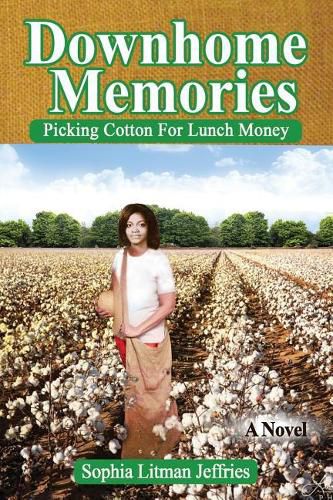Readings Newsletter
Become a Readings Member to make your shopping experience even easier.
Sign in or sign up for free!
You’re not far away from qualifying for FREE standard shipping within Australia
You’ve qualified for FREE standard shipping within Australia
The cart is loading…






Set in the rural Mississippi Delta during the year 1963, Downhome Memories: Picking Cotton For Lunch Money explores the lives and struggles of a Negro family living in the south during the racially turbulent civil rights movement. Mississippi Governor, Ross Barnett, a stanch segregationist, fought integration throughout his entire gubernatorial term. The subsequent Governor, Paul Johnson, a devout separatist, in a one-party state, won on his campaign theme, Stand tall with Paul against those wanting to change Mississippi’s way of life. Johnson’s popular campaign stump line used among his supporters, assured him of an easy win. He said, The NAACP stands for Niggers, Alligators, Apes, Coons, and Possums. Common white separatist tactics used against Negroes’ during the sixties were, Jim Crow Laws, fire bombings, literacy tests, poll taxes, KKK night-riders and lynchings. The Negro community fought discrimination and violence through the courageous efforts and uncompromising voices of the NAACP. The enactment of federal civil and voting rights laws brought hope and courage to a disenfranchised community of people. SNCC (Student Non-Violent Coordinating Committee) used revolutionary-thinking organizers, field secretaries and volunteers to protest civic and social injustices. Protest marches, organized by religious and civic leaders, sparked a civil rights movement that made gigantic strides in breaking down racial barriers. A cry for human rights, and freedom was heard across America, and, at last, change came. Through the eyes of thirteen-year-old Velma Louise Jones, and her family, experience the complexities and nuances of integration as it weaved its way into the fabric of the Negro community. We watch drama unfold as Velma interacts with her family, friends and community, and picks cotton for the first time to gain a sense of independence. Moreover, we experience the ever-changing life cycles of the large, three-generation extended, Jones Family. What happens when a black family discovers that they share common ancestors with one of the richest white families in town? What happens when the rich white family is forced to deal with the reality that they are descendants of a black matriarch? Can the injustices of slavery be made right for the fifth-generation black descendants of Effie Bailey in 1966? Is reparation the answer? If so, how do modern-day laws, greed, and systemic racism factor into a fair and equitable outcome for the black heirs?Downhome Memories: Picking Cotton For Lunch Money is a tribute to the true beauty and strength of the black community when it instinctively took on the role of a village, mentor, and protector for every child.
$9.00 standard shipping within Australia
FREE standard shipping within Australia for orders over $100.00
Express & International shipping calculated at checkout
Set in the rural Mississippi Delta during the year 1963, Downhome Memories: Picking Cotton For Lunch Money explores the lives and struggles of a Negro family living in the south during the racially turbulent civil rights movement. Mississippi Governor, Ross Barnett, a stanch segregationist, fought integration throughout his entire gubernatorial term. The subsequent Governor, Paul Johnson, a devout separatist, in a one-party state, won on his campaign theme, Stand tall with Paul against those wanting to change Mississippi’s way of life. Johnson’s popular campaign stump line used among his supporters, assured him of an easy win. He said, The NAACP stands for Niggers, Alligators, Apes, Coons, and Possums. Common white separatist tactics used against Negroes’ during the sixties were, Jim Crow Laws, fire bombings, literacy tests, poll taxes, KKK night-riders and lynchings. The Negro community fought discrimination and violence through the courageous efforts and uncompromising voices of the NAACP. The enactment of federal civil and voting rights laws brought hope and courage to a disenfranchised community of people. SNCC (Student Non-Violent Coordinating Committee) used revolutionary-thinking organizers, field secretaries and volunteers to protest civic and social injustices. Protest marches, organized by religious and civic leaders, sparked a civil rights movement that made gigantic strides in breaking down racial barriers. A cry for human rights, and freedom was heard across America, and, at last, change came. Through the eyes of thirteen-year-old Velma Louise Jones, and her family, experience the complexities and nuances of integration as it weaved its way into the fabric of the Negro community. We watch drama unfold as Velma interacts with her family, friends and community, and picks cotton for the first time to gain a sense of independence. Moreover, we experience the ever-changing life cycles of the large, three-generation extended, Jones Family. What happens when a black family discovers that they share common ancestors with one of the richest white families in town? What happens when the rich white family is forced to deal with the reality that they are descendants of a black matriarch? Can the injustices of slavery be made right for the fifth-generation black descendants of Effie Bailey in 1966? Is reparation the answer? If so, how do modern-day laws, greed, and systemic racism factor into a fair and equitable outcome for the black heirs?Downhome Memories: Picking Cotton For Lunch Money is a tribute to the true beauty and strength of the black community when it instinctively took on the role of a village, mentor, and protector for every child.